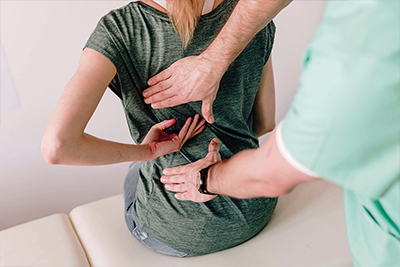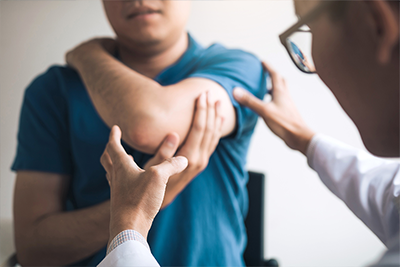A pinched nerve is a nerve that has become compressed or pinched. The development of this condition occurs when your nerve root is inflamed or injured. Your nerve root is the section where your nerve branches away from your spinal cord. Your nerves extend from both your spinal cord and brain. This is how important messages are sent all over your body. The body often sends warning signals when there is a pinched nerve such as pain. You should not ignore the warning signals you are receiving.
A pinched nerve can result in severe or minor damage. The problem can be either long-term or temporary. The sooner you receive a diagnosis and treatment for your pinched nerve, the faster you will find relief. In some instances, the damage resulting from a pinched nerve is irreversible. You can generally relieve your symptoms including pain with treatment. The individuals most commonly affected with a pinched nerve are between the ages of 50 and 54.
Older and middle-aged adults often have degeneration of the spine. As time passes, the discs can become shorter. The vertebrae then become compressed, irritating the nearby nerves. Your nerves can also become compressed due to bone growths. If you have a pinched nerve in your neck, you may experience a sensation of pins and needles or weakness and pain in your hand, arm or shoulder.
Symptoms of Pinched Nerves
Sometimes, pain is the only sign of nerve compression. You can have other symptoms without feeling any pain. The most commons symptoms of a trapped nerve include:
- Pain in the area your trapped nerve is located such as your lower back or neck
- Muscle weakness
- Tingling or numbness
- Poor range of motion in your neck
- A burning sensation or pins and needles
- Radiating pain including radicular pain or sciatica
- Pain when you move your head or neck
When you use specific movements, your symptoms can become worse. This includes straining your neck and turning your head.
Causes of Pinched Nerves
A trapped or pinched nerve occurs when pressure is placed on your nerve. This can be caused by repetitive motions or when keeping your body in the same position for a long period of time. A good example is if you keep your elbows bent when you are sleeping. When your nerves are traveling through the narrow spaces throughout your body they are more vulnerable. This is because there is not enough soft tissue for proper protection.
Trapped nerves often result when your nerve is pressed between your tissues including bone, tendon and ligament. A good example is pain in your lower back or neck due to pressure or inflammation placed on a nerve root in your spine. You can also experience cervical radiculopathy which is pain radiating from your neck to your shoulder and arm. Sciatic or lumbar radiculopathy can cause pain to radiate into your leg and foot. These symptoms can occur due to changes in your spine’s bones and discs.
If one of your discs slips out of the correct position and protrudes, it is called a herniated disc. The result is pressure placed on your spinal nerve. You can feel symptoms from a trapped nerve in your arm or neck in your hand, fingers, elbow or wrist. This can cause other conditions including carpal tunnel syndrome and peripheral neuropathy.
If your nerve compression continues for too long, the protective barrier surrounding your nerve can start to break down causing a fluid build-up resulting in scarring, extra pressure and swelling. In some cases, scarring can cause interference with the function of your nerve.
Relieving Trapped Nerve Pain
The best stretches for trapped nerve symptoms can be demonstrated by a physical therapist. If your pain is mild, you might only need gentle exercises to stretch your neck muscles and relieve the pressure on your nerve. You should perform these exercises slowly to prevent more nerve damage. You can perform the following exercises while standing or sitting down.
Chin Tuck:
Chin tucks decrease the tension in your neck through lengthening. You will also improve your posture in your neck and head.
- Put your fingers on your chin
- Push your chin gently toward your neck and stop when you have a double chin
- Hold your position for three to five seconds then relax
- Repeat between three and five times
- After you have become comfortable with the movement, try it without your fingers
Chin Tuck with Extension:
Additional movement can be added to chin tucks to stretch your neck in another direction. Some individuals will experience dizziness. If this happens, do not perform this exercise.
- Pull your head back
- Tilt your head slowly toward the ceiling
- Go back to your original position and relax
- Perform five reps two times
Trap Stretch:
Your trapezius muscles are located in the back of the neck. If your muscles are too tight, your nerves and spine can become compressed. The trap stretch loosens your muscles for the release of trapped nerves.
- Put your right hand beneath your thigh
- Use your left hand to bend your head gently to the left
- Hold for 30 seconds, then repeat three times for both sides
Neck Bend:
This type of exercise offers relief if your trapped nerve is located in your neck. Neck bends need to be performed slowly.
- Move your chin down gently toward your chest
- Pause, then return to your starting position
- Repeat between five and 10 times
Head Turn:
The range of motion in your neck can be decreased due to a trapped nerve. This exercise should be performed in a controlled and slow manner, If you experience pain, smaller movements may help.
- Straighten your neck and head and look ahead
- Turn your head slowly to the right and hold for five to 10 seconds
- Turn to the left slowly, and hold for five to 10 seconds
- Your head can also be tilted up and down and from side to side
Shoulder Roll:
This exercise releases tension in your neck and shoulders and can help relieve pain and pressure from a trapped nerve.
- Begin by lifting your shoulder blades up, then rolling them back and down
- Repeat between five and six times
- Begin again in the opposite direction
There are other treatments for trapped nerves in addition to stretches. You can use these methods for reducing pain, loosening tight muscles and decompressing nerves. If your symptoms are mild, you can try:
- Resting
- NSAIDs
- Cold or hot compresses
- Massage
- Soft cervical collar
- Acupuncture
- Practice good posture
- Yoga
Changing Your Posture:
You can make a trapped nerve worse with poor posture. When you stand or sit for long periods of time using poor posture you are placing unnecessary stress on your body. This can damage your muscles and spine resulting in a trapped nerve. You can help your nerve to heal by relieving pressure. Try neck rests, adjustable chairs and cushions.
Medications for Pain:
Purchasing pain medications over the counter can help with your trapped nerve. For minor pinched nerves, NSAIDs can help relieve pain and help decrease swelling. You can purchase NSAIDs including ibuprofen online or at your local drugstore. Consulting with your physician is important for all drugs including NSAIDs for potential interactions and dosage recommendations.
Heat and Ice Packs:
Switching between ice packs and heat can often help decrease your inflammation and swelling. The combination of cold and hot helps increase your fresh blood circulation to the area which can help with your pain. Place an ice pack on the area for approximately 15 minutes three times every day to help decrease your inflammation. You can use a heating pad for a maximum of one hour three times each day. You can purchase heat and ice packs for injuries online.
Extra Rest and Sleep:
Your nerves require sleep to heal. During sleep, your body will repair itself. You can often help decrease your symptoms faster with additional periods of sleep and rest. In many instances, getting more sleep and allowing the affected area to rest will enable your trapped nerve to heal by itself. Making certain your nerve is not overused is very important during your treatment.
Overuse can make your nerve damage worse. Anyone with a trapped nerve needs to eliminate any movements irritating the nerve. Try sleeping in a position that will relieve the pressure placed on your nerve.
Physical Therapy and Massage:
You can help decrease your stress and physical pain just by getting a massage. Tension can often be relieved when gentle pressure is applied around the area affected. Your muscles will generally relax when you have a full body massage. Deep tissue massages are not usually recommended since your symptoms can worsen due to the extra pressure. You can also help relieve your symptoms with physical therapy. Chiropractic therapists use a combination of gentle stretches, massage and exercise.
Ergonomic Workstation:
Changing your workstation can help with your trapped nerve. You might be able to decrease the pressure in your wrists and hands by using a good quality ergonomic keyboard and mouse. You can help relieve the pain and symptoms in your neck by raising your computer monitor until it reaches your eye level. Back pain can often be decreased through the use of a standing workstation to ensure your spine is flexible and can move freely.
You can choose different positions with an ergonomic workstation. This is appropriate for numerous different types of trapped nerves. You can purchase a standing desk online. Experiment with the different settings to find the best position for relieving pressure and your specific needs.
Elevating Your Legs
If your trapped nerve is in your back, elevating your legs can bring relief by removing any pressure on your spine. Your best option is placing a couple of pillows beneath your knees. Make sure your legs remain at a 45-degree angle to your torso.
Yoga and Stretching:
Yoga and gentle stretches can help relieve the pressure and tension you are feeling in the area. Make certain you do not stretch too deeply or you can make your symptoms worse. If you experience discomfort or pain while you are exercising, stop immediately or you can cause more damage to your nerve.
Splint:
Whenever possible wear a splint on the area to help your nerve heal and stop more damage. This treatment is standard for pinched nerves in the wrists and hands. You can help stop the area from becoming irritated during the night and improve your sleep by wearing your splint to bed. Your split will help alleviate pressure on your nerve.
Lifestyle Changes:
Making changes to your lifestyle such as including walking, low-impact exercise, bicycling and swimming can help your body stay in shape and can help decrease your symptoms. You can decrease the pressure on your trapped nerve by losing excess weight and often decrease inflammation by increasing your mobility with regular exercise. Stretching after or before performing low-impact exercises can decrease inflammation and pressure near your nerve while keeping your body flexible.
When to Get Proper Medical Care
If your pain persists, you need to call your physician. If you believe you have a trapped nerve and the pain does not go away after a couple of days, medical attention is necessary. If your pain becomes worse after using the self-care and stretching options in this article, ask for help. Unexpected pain or weakness in a specific area is called acute focal weakness. A good example is if your entire right leg is no longer capable of carrying your weight.
If this occurs or you lose control of your bladder or bowels, see a physician. Pay attention to both your pain and your body. If you are concerned about your symptoms, consult with your doctor. If you experience an unexpected pain in your left arm, go to the emergency room or call 999 immediately because it can be a symptom of a heart attack. If you lose sensation or have a profound numbness, this can be a symptom of a stroke and urgent and immediate medical attention may be required.
Related Articles
- Chiropractor or Osteopath for a Trapped Nerve or Sciatica
- 8 Signs You Need to Visit the Chiropractor
- Chronic Pain Can Be More Harmful Than You Believe
- Back Pain Myths
- Pudendal Neuralgia (Pelvis Nerve Pain) Symptoms & Treatment




























